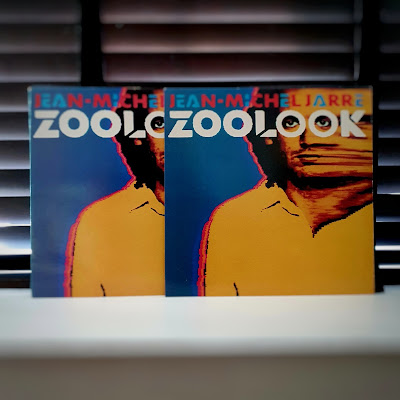"The Concerts In China" is a double album that documented (and paid for) Jarre's 1981 concerts in Beijing and Shanghai.
This record contains live renditions of previously released tracks along with 'over 40 minutes' of new material.
Much like Japan's "Oil On Canvas", there is much debate as to just how 'live' these recordings are. Most artists edit, mix and overdub their live recording to make them sound better, but with this record I get the feeling the post production changes amounted to more than a few minor embellishments.
There's no doubt that the coda, "Souvenir Of China" is a studio recording as it was written after the tour. Whilst "Orient Express" seems to have been played during some of the concerts, I strongly suspect the version heard on the album wasn't captured in front of a live audience.
We get some indication of just how much post-production went into these tracks if we compare it to other sources such as the recording of the first Beijing concert that was broadcast by Dutch radio or the VHS of the album. The music on these recordings is unvarnished and comes replete with mistakes and even some different arrangements. Whilst we know the content of the shows evolved during the course of the tour, this doesn't fully account for the obvious gulf between these raw recordings and the finished product.
So there is no doubt there is a considerable amount of studio augmentation going on and this record doesn't reflect exactly what was heard in the concert halls. I guess its down to the individual to decide if that matters or not. As with many things Jarre does, you are supposed to enjoy the spectacle and ignore the details.
I own a copy of the "40th Anniversary Edition" of this album but haven't played it yet. From what I read on Discogs the audio on this version is compressed and the discs may even have issues with skipping, so I will need to investigate that at some stage. With this in mind, we will spin a copy of the original UK pressing from 1982.
The album begins with "The Overture" which is brooding piece that uses the same sequences as "Magnetic Fields Part I" at a much slower tempo. After this great opening we move on to one of the most revered tracks from this album with the stunning "Arpegiator". Yes, the title is unimaginative but the music is a sublime slice of early eighties electronica that deserves to be lauded as one of Jarre's best. The first side closes with a rendition of "Equinoxe IV" which sees Roger Rizzitelli dominate the rest of the band by enthusiastically attacking his Simmons kit.
Side two starts with an arrangement of a traditional Chinese tune "Fisherman's Song at Dusk" but the sleeve gives the impression it was written by Jarre. At nearly ten minutes in length this can be a test of even the most ardent Jarre fans stamina, but the synthesiser driven sections are entertaining enough. There is a short rendition of "Band in the Rain" from "Equinoxe", which is only significant because it was the first time the piece was given a title. The long meandering introduction to "Equinoxe VII" builds a tension that resolves with the introduction of the songs sequenced bassline and the audience clapping along completely out of time. The ten minutes of this song pass in a blur of melody, Fairlight samples and a merciful respite from the Simmons kit of Rizzitelli.
The second disc opens with "Orient Express" which is a new composition that features a poppy melody over a disco bassline. Whilst this song is passable, it isn't exactly Jarre at his peak. The sleeve notes mislead us into thinking the next track is "Magnetic Fields Part I" but in reality it is just a sample of pong pong balls - this has always mystified and annoyed me in equal measure. Up next is a version of "Magnetic Fields Part III" which gives way to a lively and entertaining version of "Magnetic Fields Part IV" which the crowd seem to respond to enthusiastically.
"Laser Harp" would probably have been a more entertaining spectacle when seen live and the rather tuneless piece Jarre generates with his new found toy is nothing to write home about. "Night In Shanghai" is another new track which sees Jarre sampling traditional Chinese instruments and running them through his Fairlight. After about two minutes a sequence starts up and the piece begins to gather some momentum and once it is up and running this is an entertaining piece. On this album "Magnetic Fields Part V" is rechristened "The Last Rhumba" and isn't a track I enjoy much. The finale to the concerts was always a stirring rendition of "Magnetic Fields Part II" which has the most amazing solo by Dominique Perrier. A new studio recording "Souvenir Of China" is tagged onto the end of the album and fits quite well. Personally I'm not too keen on the track as it seems very ponderous and largely devoid of melody, but it doesn't detract too much from what has gone before. 3.5/5








